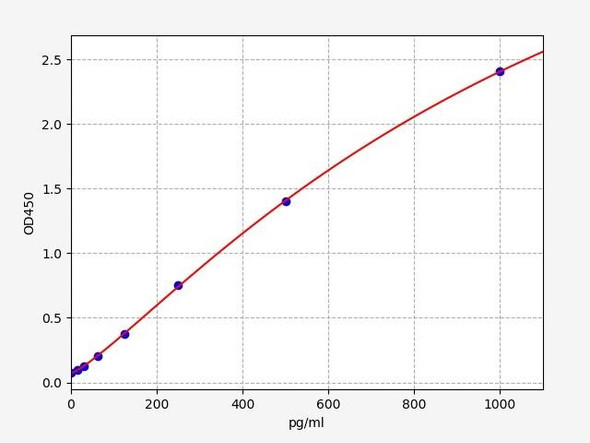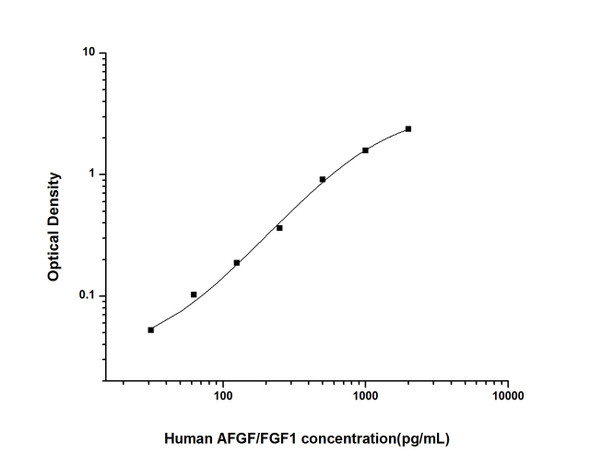Rat FGF1/FGF acidic ELISA Kit (RTFI00016)
- SKU:
- RTFI00016
- Product Type:
- ELISA Kit
- Size:
- 96 Assays
- Uniprot:
- P61149
- Sensitivity:
- 9.375pg/ml
- Range:
- 15.625-1000pg/ml
- ELISA Type:
- Sandwich
- Synonyms:
- AFGF, FGF1, FGF-1, HBGF-1, AFGF, aFGF, alpha, ECGF, ECGFB, ECGF-betaAcidic fibroblast growth factor, endothelial cell growth factor, beta, FGFABeta-endothelial cell growth factor, FGF-alpha, fibroblast growth factor 1, acidic, GLIO703, HBGF1, HBGF-1,
- Reactivity:
- Rat
- Research Area:
- Cardiovascular
Description
Rat FGF1/FGF acidic ELISA Kit
Based on the information from the URL provided, the Rat FGF1 (FGF acidic) ELISA Kit is a cutting-edge tool designed for the precise measurement of FGF acidic levels in rat serum, plasma, and cell culture media. This kit offers exceptional sensitivity and specificity, ensuring accurate and consistent results for various research applications.FGF acidic, also known as FGF1, is a critical factor involved in regulating cell growth, tissue repair, and angiogenesis. With its role in promoting cell proliferation and differentiation, FGF1 is a key player in various physiological and pathological processes.
By detecting FGF acidic levels, researchers can gain insights into mechanisms underlying diseases like cancer, cardiovascular disorders, and metabolic conditions.The Rat FGF1 (FGF acidic) ELISA Kit provides a valuable tool for studying FGF1's functions and potential therapeutic interventions. Its reliability and performance make it an indispensable asset for researchers exploring the complex biology of FGF acidic in rat models. Unlock the potential of your research with this advanced ELISA kit from AssayGenie.
| Product Name: | Rat FGF1/FGF acidic ELISA Kit |
| Product Code: | RTFI00016 |
| Size: | 96 Assays |
| Target: | Rat AFGF/FGF1 |
| Alias: | AFGF, FGF1, FGF-1, HBGF-1, AFGF, aFGF, alpha, ECGF, ECGFB, ECGF-betaAcidic fibroblast growth factor, endothelial cell growth factor, beta, FGFABeta-endothelial cell growth factor, FGF-alpha, fibroblast growth factor 1, acidic, GLIO703, HBGF1, HBGF-1, heparin-binding growth factor 1 |
| Reactivity: | Rat |
| Detection Method: | Sandwich ELISA, Double Antibody |
| Sensitivity: | 9.375pg/ml |
| Range: | 15.625-1000pg/ml |
| Storage: | 4°C for 6 months |
| Note: | For Research Use Only |
| Recovery: | Matrices listed below were spiked with certain level of Rat AFGF/FGF1 and the recovery rates were calculated by comparing the measured value to the expected amount of Rat AFGF/FGF1 in samples. | ||||||||||||||||
| |||||||||||||||||
| Linearity: | The linearity of the kit was assayed by testing samples spiked with appropriate concentration of Rat AFGF/FGF1 and their serial dilutions. The results were demonstrated by the percentage of calculated concentration to the expected. | ||||||||||||||||
| |||||||||||||||||
| Intra-Assay: | CV <8% | ||||||||||||||||
| Inter-Assay: | CV <10% |
| Uniprot: | P61149 |
| UniProt Protein Function: | FGF1: Plays an important role in the regulation of cell survival, cell division, angiogenesis, cell differentiation and cell migration. Functions as potent mitogen in vitro. Monomer. Homodimer. Interacts with FGFR1, FGFR2, FGFR3 and FGFR4. Affinity between fibroblast growth factors (FGFs) and their receptors is increased by heparan sulfate glycosaminoglycans that function as coreceptors. Found in a complex with FGFBP1, FGF1 and FGF2. Interacts with FGFBP1. Part of a Cu(2+)-dependent multiprotein aggregate containing FGF1, S100A13 and SYT1. Interacts with SYT1. Interacts with S100A13. Belongs to the heparin-binding growth factors family. 2 isoforms of the human protein are produced by alternative splicing. |
| UniProt Protein Details: | Protein type:Motility/polarity/chemotaxis; Cytokine; Cell development/differentiation Cellular Component: nucleoplasm; extracellular space; proteinaceous extracellular matrix; cytoplasm; nucleolus; extracellular region; cytosol; nucleus Molecular Function:heparin binding; protein binding; growth factor activity; Hsp70 protein binding; receptor binding; fibroblast growth factor receptor binding Biological Process: fibroblast growth factor receptor signaling pathway; positive regulation of transcription, DNA-dependent; multicellular organismal development; positive regulation of cholesterol biosynthetic process; cardiac muscle cell proliferation; positive regulation of MAP kinase activity; cell proliferation; positive regulation of angiogenesis; positive regulation of cell division; induction of an organ; positive regulation of cell proliferation; positive regulation of transcription from RNA polymerase II promoter; positive regulation of protein amino acid phosphorylation; angiogenesis; cell differentiation; positive regulation of epithelial cell proliferation; lung development; positive regulation of cell migration |
| NCBI Summary: | may play a role in neurite outgrowth; may regulate cell differentiation in the nervous system; may act in synergy with fibronectin to enhance neuronal cell adhesion [RGD, Feb 2006] |
| UniProt Code: | P61149 |
| NCBI GenInfo Identifier: | 47117672 |
| NCBI Gene ID: | 25317 |
| NCBI Accession: | P61149.1 |
| UniProt Secondary Accession: | P61149,P10935, |
| UniProt Related Accession: | P61149 |
| Molecular Weight: | 17,418 Da |
| NCBI Full Name: | Fibroblast growth factor 1 |
| NCBI Synonym Full Names: | fibroblast growth factor 1 (acidic) |
| NCBI Official Symbol: | Fgf1 |
| NCBI Official Synonym Symbols: | FGF-1; HBGF1; HBGF-1 |
| NCBI Protein Information: | fibroblast growth factor 1; aFGF; acidic fibroblast growth factor; heparin-binding growth factor 1; Fibroblast growth factor 1 (heparin binding) |
| UniProt Protein Name: | Fibroblast growth factor 1 |
| UniProt Synonym Protein Names: | Acidic fibroblast growth factor; aFGF; Heparin-binding growth factor 1; HBGF-1 |
| Protein Family: | Fibroblast growth factor |
| UniProt Gene Name: | Fgf1 |
| UniProt Entry Name: | FGF1_RAT |
| Step | Procedure |
| 1. | Set standard, test sample and control (zero) wells on the pre-coated plate respectively, and then, record their positions. It is recommended to measure each standard and sample in duplicate. Wash plate 2 times before adding standard, sample and control (zero) wells! |
| 2. | Aliquot 0.1ml standard solutions into the standard wells. |
| 3. | Add 0.1 ml of Sample / Standard dilution buffer into the control (zero) well. |
| 4. | Add 0.1 ml of properly diluted sample ( Human serum, plasma, tissue homogenates and other biological fluids.) into test sample wells. |
| 5. | Seal the plate with a cover and incubate at 37°C for 90 min. |
| 6. | Remove the cover and discard the plate content, clap the plate on the absorbent filter papers or other absorbent material. Do NOT let the wells completely dry at any time. Wash plate X2. |
| 7. | Add 0.1 ml of Biotin- detection antibody working solution into the above wells (standard, test sample & zero wells). Add the solution at the bottom of each well without touching the side wall. |
| 8. | Seal the plate with a cover and incubate at 37°C for 60 min. |
| 9. | Remove the cover, and wash plate 3 times with Wash buffer. Let wash buffer rest in wells for 1 min between each wash. |
| 10. | Add 0.1 ml of SABC working solution into each well, cover the plate and incubate at 37°C for 30 min. |
| 11. | Remove the cover and wash plate 5 times with Wash buffer, and each time let the wash buffer stay in the wells for 1-2 min. |
| 12. | Add 90 µL of TMB substrate into each well, cover the plate and incubate at 37°C in dark within 10-20 min. (Note: This incubation time is for reference use only, the optimal time should be determined by end user.) And the shades of blue can be seen in the first 3-4 wells (with most concentrated standard solutions), the other wells show no obvious color. |
| 13. | Add 50 µL of Stop solution into each well and mix thoroughly. The color changes into yellow immediately. |
| 14. | Read the O.D. absorbance at 450 nm in a microplate reader immediately after adding the stop solution. |
When carrying out an ELISA assay it is important to prepare your samples in order to achieve the best possible results. Below we have a list of procedures for the preparation of samples for different sample types.
| Sample Type | Protocol |
| Serum: | If using serum separator tubes, allow samples to clot for 30 minutes at room temperature. Centrifuge for 10 minutes at 1,000x g. Collect the serum fraction and assay promptly or aliquot and store the samples at -80°C. Avoid multiple freeze-thaw cycles. If serum separator tubes are not being used, allow samples to clotovernight at 2-8°C. Centrifuge for 10 minutes at 1,000x g. Removeserum and assay promptly or aliquot and store the samples at-80°C. Avoid multiple freeze-thaw cycles. |
| Plasma: | Collect plasma using EDTA or heparin as an anti-coagulant. Centrifuge samples at 4°C for 15 mins at 1000 × g within 30 mins of collection. Collect the plasma fraction and assay promptly or aliquot and store the samples at -80°C. Avoid multiple freeze-thaw cycles.Note: Over haemolysed samples are not suitable for use with this kit. |
| Urine & Cerebrospinal Fluid: | Collect the urine (mid-stream) in a sterile container, centrifuge for 20 mins at 2000-3000 rpm. Remove supernatant and assay immediately. If any precipitation is detected, repeat the centrifugation step. A similar protocol can be used for cerebrospinal fluid. |
| Cell Culture Supernatant: | Collect the cell culture media by pipette, followed by centrifugation at 4°C for 20 mins at 1500 rpm. Collect the clear supernatant and assay immediately. |
| Cell Lysates: | Solubilize cells in lysis buffer and allow to sit on ice for 30 minutes. Centrifuge tubes at 14,000 x g for 5 minutes to remove insoluble material. Aliquot the supernatant into a new tube and discard the remaining whole cell extract. Quantify total protein concentration using a total protein assay. Assay immediately or aliquot and store at ≤ -20°C. |
| Tissue Homogenates: | The preparation of tissue homogenates will vary depending upon tissue type. Rinse tissue with 1X PBS to remove excess blood & homogenizein 20ml of 1X PBS (including protease inhibitors) and store overnight at ≤ -20°C. Two freeze-thaw cycles are required to break the cell membranes. To further disrupt the cell membranes you can sonicate the samples. Centrifuge homogenates for 5 mins at 5000xg. Remove the supernatant and assay immediately or aliquot and store at -20°C or-80°C. |
| Tissue Lysates: | Rinse tissue with PBS, cut into 1-2 mm pieces, and homogenize with a tissue homogenizer in PBS. Add an equal volume of RIPA buffer containing protease inhibitors and lyse tissues at room temperature for 30 minutes with gentle agitation. Centrifuge to remove debris. Quantify total protein concentration using a total protein assay. Assay immediately or aliquot and store at ≤ -20 °C. |
| Breast Milk: | Collect milk samples and centrifuge at 10,000 x g for 60 min at 4°C. Aliquot the supernatant and assay. For long term use, store samples at -80°C. Minimize freeze/thaw cycles. |






